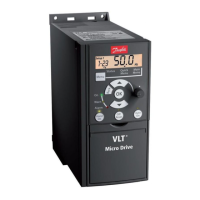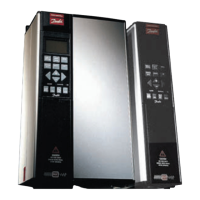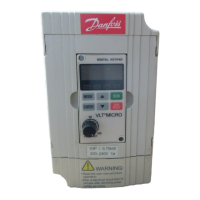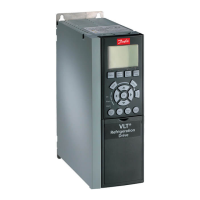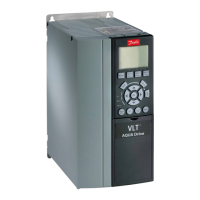VLT
®
5000 Series
■ PID for process control
F
eedback
The feedback signal must be connected to a terminal
on the frequency converter. Use the list below to
decide which terminal is to be used and which
parameters are to be programmed.
Feedback type Terminal Parameters
Pulse 33 307
Voltage 53 308, 309, 310
Current 60 314, 315, 316
Furthermore, the minimum and maximum feedback
(parameters 414 and 415) must
be set to a value in
the process unit that corresponds to the minimum
and maximum value on the terminal.
Select process unit in param
eter 416.
R
eference
A minimum and a maximum reference can be set (204
and 205), which limit the sum of all references. The
reference range cann
ot exceed the feedback range.
If one or several setpoint references are required,
the simplest way is to set such reference directly
in parameters 215
to 218. Select between the
preset references by connecting terminals 16, 17,
29, 32 and/or 33 to terminal 12. Which terminals
that are used
depends on the choice made in the
parameters of the various terminals (parameters
300, 301, 305, 306 and/or 307). Use the table
below wh
en selecting preset references.
Preset ref. msb Preset ref. lsb
Preset ref. 1
(par. 215)
00
Preset ref. 2
(par. 216)
01
Preset ref. 3
(par. 217)
10
Preset ref. 4
(par. 218)
11
If an external reference is required, this can either
be an analogue or a pulse reference. If current
is used as a feedback signal, only voltage can
be used as an analogue reference. Use the
following list to decide which terminal to use and
which parameters to program.
Reference type Terminal Parameters
Pulse 17 or 29 301 or 305
Voltage 53 or 54 308, 309, 310 or
311, 312, 313
Current 60 314, 315, 316
Relative references can be programmed. A relative
referenceisapercentagevalue(Y)ofthesumof
the external references (X). This percentage value
is added to the sum of the external references,
which produces the active reference (X + XY). See
section Handling of multi references.
If relative references are to be used, parameter 214 is to
be set to Relative [1]. This makes the preset references
relative. Furthermore, Relative reference [4] can be
programmed on terminal 54 and/or 60. If an external
relative reference is selected, the signal on the input will
beapercentagevalueofthefullrangeoftheterminal.
The relative references are added with signs.
NB!:
Terminals that are not in use should preferably
be set to No function [0].
I
nverse control
If the drive has to react with increasing speed on
and increasing feedback, Inverse must be selected in
parameter 437. Normal control means that the motor
speed decreases when the feedback signal increases.
A
nti Windup
The process controller comes with the anti windup
function in active position. This function ensures
that when either a frequency limit or a torque limit
is reached, the integrator will be set to a gain that
corresponds to the actual frequency. This avoids
integrating on an error that cannot in any case be
compensated for by means of a speed change. This
function can be disabled in parameter 438.
S
tart-up conditions
In some applications, optimum setting of the process
controller will mean that it takes an excessive time
for the desired process value to be reached. In
such applications it might be an advantage to fix a
motor frequency to which the frequency converter is
to bring the motor before the process controller is
activated. This is done by programming a Process
PID start frequency in parameter 439.
D
ifferentiator gain limit
If there are quick changes in reference or feedback
in a given application - which means that the error
changes swiftly - the differentiator may soon become
too dominant. This is because it reacts to changes in
the error. The quicker the error changes, the stronger
the differentiator gain is. The differentiator gain can
thus be limited to allow setting of the reasonable
differentiation time for slow changes and a suitably
MG.51.A9.02 - VLT is a registered Danfoss trademark
90

